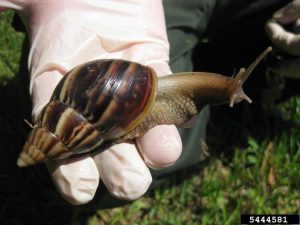
By now you have heard about the discovery of Giant African Lands Snails in Pasco County, which is a nonnative, invasive mollusk. The area is currently under a quarantine which prohibits the movement of plant materials in or out of the New Port Richey area. Please do not transport any vegetation from the area to your yard in Polk County.
Giant African Land Snails were first found in South Florida a few years ago and have since been eradicated. The extensive eradication cost millions of dollars. This is one reason why it is so important that we all work together, towards eradication, now.
Snails are not new pests to most gardeners. In fact, the USDA states that “Numerous species of exotic snails are serious pests of plants and threats to public health. All snails in the subfamily Achatininae, including the giant African snail (GAS) (Lissachatina fulica), are regulated plant pests.” UF/IFAS has numerous publications on the wide variety of snails that gardeners may encounter when working in their yards.
So, why the concern with the Giant African Land Snails?
Giant African Land Snails are, as the name implies, very large snails that can consume over 500 species of plants, many of significant agricultural importance.
They also can carry pathogens, such as Rat Lungworm, a parasite that can cause eosinophilic meningitis in both humans and livestock. It is important to remember to wear gloves and/or wash your hands when handling this, or any other type of snail that you may encounter.
These snails can travel long distances when clinging to vehicles, are primarily active at night, and can produce many thousands of offspring each. It’s thought they can even bury themselves in the soil and remain inactive for a year if local environmental conditions aren’t ideal.
Report sightings and learn more:
The detection of Giant African Land Snails in Pasco County is thanks to a Pasco County Master Gardener. It’s up to residents like you to help keep an eye out for these large invasive snails. Florida Department of Agriculture and Consumer Services (FDACS) has provided a snail ID guide to help residents:
- Snail ID Sheet (FDACS)
The Florida Department of Agriculture and Consumer Services (FDACS) along with the Division of Plant Industries (DPI) is the group handling the monitoring, application of appropriate bait, etc. If you have questions or need identification of a snail, contact DPI at 1-888-397-1517 or go to DPIHelpline@FDACS.gov.
If you are interested in learning more about Terrestrial Snails Affecting Plants in Florida, go here.
 1
1
